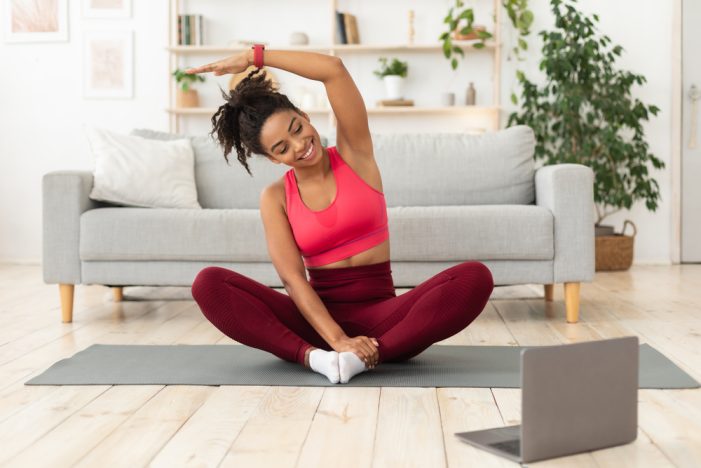By Pearl Phillip | Editorial Credit: Prostock-studio / shutterstock.com
In recent years, fitness challenges and at-home workout trends have surged in popularity, revolutionizing how people approach fitness. With the rise of social media and the influence of fitness-focused content creators, millions of people now participate in fitness challenges, share workout routines, and provide tips to stay active—often from the comfort of their homes. This movement has been further fueled by the rise of hashtags, which have helped create a sense of community and accessibility within the fitness space. The cultural impact of this shift is substantial, with increased home workout equipment sales and the booming popularity of digital fitness programs. As a result, fitness is becoming more attainable and fun, encouraging a more active lifestyle for people worldwide.
Influencers Promoting Workout Guides
One of the primary drivers of the fitness challenge and at-home workout movement has been the role of influencers who promote workout guides and fitness routines. These influencers, such as Chloe Ting, Pamela Reif, and Sydney Cummings, have played a significant role in making fitness more accessible to a wider audience. By offering affordable or free workout plans that cater to various fitness levels, these influencers have democratized fitness, making it possible for anyone with an internet connection to access structured, easy-to-follow workout programs.
Chloe Ting, for example, became a viral sensation during the COVID-19 pandemic with her 2-Week Shred Challenge, a high-intensity workout series aimed at improving fitness and toning muscles in a short period of time. The simplicity of her workouts and her encouraging personality attracted millions of followers, many of whom were looking for ways to stay active while gyms were closed. Similarly, Pamela Reif’s at-home workout videos have been widely shared for their no-equipment exercises that target specific areas like abs, legs, and arms.
What makes these influencers stand out is their ability to connect with their audience in an approachable and motivating way. Many offer comprehensive workout plans that can be done without expensive gym equipment, making fitness more accessible to people who may feel intimidated by traditional gym environments. Furthermore, these influencers often share their own fitness journeys, offering authenticity that resonates with their followers. This dynamic has created a symbiotic relationship between influencers and their audience, where the influencers provide guidance, and the community of followers shares progress, tips, and encouragement.
Social Media Users Sharing Workouts and Fitness Tips
Social media platforms, especially Instagram, TikTok, and YouTube, have become hotspots for fitness enthusiasts who want to share their routines and tips for staying fit at home. As the demand for at-home workouts grew, particularly during the pandemic, users began posting their workout schedules, tips for staying motivated, and progress photos or videos under fitness-related hashtags. This has created a strong sense of community, where individuals can connect, share, and support each other in their fitness journey.
One popular trend on TikTok and Instagram is sharing short, easily digestible workout videos. Users often film themselves performing exercises such as squats, lunges, planks, and push-ups, providing quick tutorials for others to follow. These videos are typically designed to be accessible for beginners and are often labeled with hashtags like #HomeWorkout, #FitnessChallenge, or #WorkoutMotivation. These bite-sized pieces of content cater to the fast-paced nature of social media, making it easy for users to find workouts they can try immediately.
In addition to sharing their routines, users also offer fitness tips on everything from nutrition to workout recovery. Many social media users advise incorporating stretching, proper form, and mental wellness into daily workouts. The emphasis on holistic health has expanded the conversation around fitness, making it less about achieving a particular aesthetic and more about overall well-being. By participating in these discussions, users motivate themselves and create a supportive community where others can find encouragement and advice tailored to their personal fitness goals.
Hashtags Pushing the Movement
Hashtags have been pivotal in driving the at-home workout and fitness challenge movement. With hashtags like #FitnessChallenge, #HomeWorkout, #WorkoutFromHome, #QuarantineWorkout, and #30DayChallenge, social media users can easily find, participate in, and share fitness-related content. These hashtags not only help users discover and share fitness-related content but also create online communities where users can connect with others participating in similar challenges or workout routines, fostering a sense of accountability and motivation.
For example, the hashtag #FitnessChallenge often accompanies posts about a wide range of structured challenges, such as completing a certain number of workouts over 30 days or focusing on specific fitness goals like improving core strength or endurance. These challenges are adaptable and can be tailored to individual fitness levels and goals, inspiring people to set new goals and track their progress while engaging with a larger community of participants. Users who document their fitness journeys using these hashtags contribute to a constantly growing library of workouts, tips, and motivational content from which others can draw inspiration.
Hashtags like #QuarantineWorkout and #HomeWorkout gained significant traction during the COVID-19 pandemic, as gyms were forced to close and people had to find alternative ways to stay active. These hashtags helped unite a global community of people trying to maintain their fitness during uncertain times. Whether sharing creative ways to use household items as workout equipment or posting motivational quotes to keep others moving, these hashtags have been instrumental in keeping the at-home workout movement alive and thriving.
Cultural Impact: Increased Home Workout Equipment Sales and Digital Fitness Programs
One of the most significant cultural impacts of the rise of fitness challenges and at-home workouts has been the increased demand for home workout equipment and digital fitness programs. As more people shifted to working out from home, equipment sales such as dumbbells, resistance bands, yoga mats, and stationary bikes skyrocketed. Companies like Peloton, which offers high-end home exercise bikes and virtual fitness classes, saw massive growth in both sales and subscriptions during the pandemic.
According to reports, the global home fitness equipment market grew substantially during 2020 and 2021, with brands like Bowflex, NordicTrack, and Tonal seeing a surge in interest. Resistance bands and adjustable dumbbells, in particular, became highly sought-after as people looked for versatile, space-saving equipment for small apartments or home offices. The cultural shift toward home fitness has expanded the market for these products and prompted fitness brands to innovate by creating customized home-use equipment.
Simultaneously, digital fitness programs and apps like Nike Training Club, Apple Fitness+, and ClassPass have experienced a surge in popularity. These platforms offer users a variety of guided workouts that can be streamed on-demand, empowering people to follow along with professional trainers from anywhere. Many of these programs provide structured workout plans that mimic the experience of going to a gym or attending a fitness class, but with the added convenience of exercising at home. The accessibility and flexibility of digital fitness programs have broadened the fitness landscape, giving people more control over their fitness journey and making it easier to incorporate physical activity into their daily lives, regardless of their location or schedule.
Encouraging a More Active Lifestyle: Making Fitness Attainable and Fun
The cultural impact of fitness challenges and at-home workouts extends beyond increased equipment sales and digital programs. One of the most favorable outcomes of this movement is how it has encouraged a more active lifestyle for a wide range of people, making fitness feel more attainable and fun. By breaking down barriers such as expensive gym memberships, intimidating gym environments, or lack of time, at-home workouts have democratized fitness and empowered people to take control of their health on their own terms.
The nature of fitness challenges has made working out more engaging and goal-oriented. Challenges often involve a specific time frame—such as a 30-day plank challenge or a 2-week ab workout routine—that gives participants a clear goal to work toward. The sense of achievement that comes from completing these challenges, combined with the visible progress that many users document, has created a motivating cycle where more people are encouraged to start their own fitness journey.
The social media aspect of these challenges adds an element of community and fun, with users sharing their progress, swapping tips, and celebrating each other’s achievements. By framing fitness as something that can be done at home, in small chunks of time, and with minimal equipment, these challenges help remove the intimidation factor that often comes with traditional exercise routines. Fitness influencers and everyday users emphasize that anyone can start moving, regardless of their current fitness level, making it more appealing for beginners to jump in and try new workouts.
Additionally, fitness challenges often feature various exercise types, from high-intensity interval training (HIIT) to yoga, Pilates, and bodyweight strength training. This variety makes it easier for people to find exercises they enjoy, which can lead to a more sustainable and long-term commitment to staying active. The emphasis on fun, exploration, and personal progress has shifted the cultural perception of fitness from a chore or obligation to a source of joy, empowerment, and self-care.
Profound Cultural Impact
The rise of fitness challenges and at-home workouts, driven by influencers, social media users, and hashtags, has had a profound cultural impact. Influencers have democratized access to workout guides, while social media users have contributed to a growing community of fitness enthusiasts sharing routines and tips. Hashtags have united people around shared fitness goals, creating a global movement encouraging active living.
The cultural impact is clear in the increased sales of home workout equipment and the growth of digital fitness platforms, which have transformed how people approach exercise. More importantly, the movement has made fitness feel more attainable, inclusive, and enjoyable for people of all backgrounds. By fostering community and personal empowerment, fitness challenges and at-home workouts have helped countless individuals incorporate regular physical activity into their lives, contributing to a healthier and more active society.
Pearl Phillip is the host of Beauty, Health & Wellness Radio Show and Podcast, and Managing & Editor-in-Chief of Caribbean American Weekly, The Immigrant’s Journal & Workers’ World Today Publications and a Consultant with New Black Voices. Learn more at http://www.

